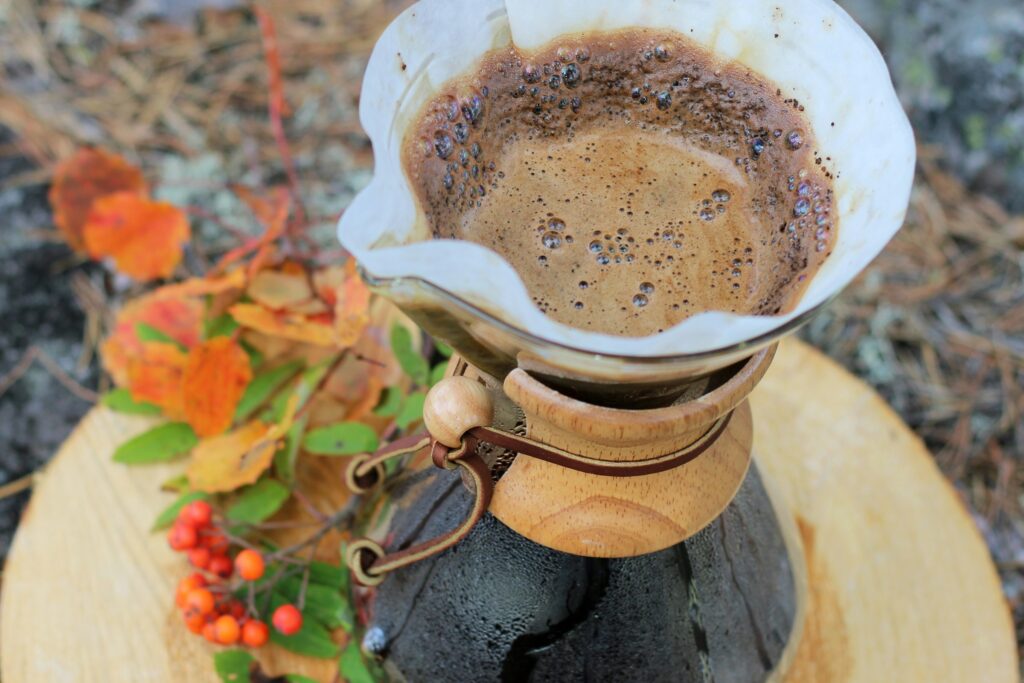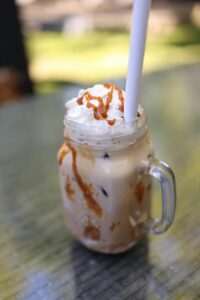We’ve all been there—excited for that first sip, only to end up with coffee that tastes like burnt rubber or flavored water. One wrong move, and your morning brew turns into a disappointment.
Brewing coffee isn’t rocket science, but it is a mix of precision and care. Even small slip-ups like grinding too fine or pouring too hot can throw off the whole cup.
The good news? Every mistake has a simple fix.
This guide breaks down the most common brewing blunders and shows you exactly how to turn them into consistently delicious coffee!
1. Using the Wrong Grind Size
The Mistake
Grind size is one of the biggest culprits behind a disappointing cup. When the grind is too fine, water clings to the grounds for too long. The result? Bitter, harsh, almost “burnt” tasting coffee.
On the flip side, if your grind is too coarse, water rushes through too quickly, leaving you with a weak, watery brew that tastes like someone just waved a coffee bean over hot water.
The Fix
The sweet spot depends entirely on how you brew. French press? Go coarse, like sea salt. Drip coffee makers? Medium grind, like sand. Espresso machines? Fine grind, almost like powdered sugar.
The idea is to match the size of the grind to the amount of time water spends with the coffee. Longer contact time (like French press) needs bigger pieces.
Shorter time (like espresso) needs tiny ones. Once you make this connection, the “mystery” of grind size suddenly makes sense.
The Tip
Consistency is everything. That’s why a burr grinder is a game-changer. Blade grinders chop beans unevenly, leaving you with both powder and boulders in the same batch.
That unevenness leads to a confusing cup—some grounds over-extracted, some under-extracted, all fighting each other.
Burr grinders crush beans into uniform pieces, giving you predictability.
2. Incorrect Water Temperature
The Mistake
Water temperature is like the hidden puppet master of coffee flavor. Too hot and your coffee tastes scorched, bitter, and flat—as if the beans were roasted twice.
Too cool, and you’ll wonder if you accidentally brewed flavored water. Both ends of the spectrum rob your cup of the balance it deserves.
It’s frustrating because the beans might be great, but the wrong temperature turns them into a letdown.
The Fix
The sweet spot lives between 195°F and 205°F (about 90–96°C). At this range, the water is hot enough to pull out the rich flavors, but not so aggressive that it burns them out.
Whether you’re using a pour-over, French press, or drip machine, staying in this window makes a world of difference.
The Hack
No thermometer? No problem. Bring your water to a boil, then let it sit for about 30–45 seconds before pouring. That short wait usually drops it right into the perfect zone.
It’s a quick trick that works surprisingly well. You can also listen—boiling water roars; once it calms to a quiet shimmer, you’re good to go.
3. Using the Wrong Coffee-to-Water Ratio
The Mistake
Eyeballing your coffee grounds might feel quick and easy, but it’s a recipe for inconsistency. One day your cup tastes like rocket fuel, the next it’s as weak as tea left in the sun.
Guessing the ratio is like throwing darts in the dark—you’ll hit the target sometimes, but most of the time you’ll miss. Even the best beans can’t save you if the balance between coffee and water is off.
The Fix
Enter the “Golden Ratio.” This simple guideline keeps you on track: about 1–2 tablespoons of coffee per 6 ounces of water, or roughly 1:15–1:17 by weight if you’re measuring in grams.
This isn’t a hard rule but a reliable starting point. Want a stronger cup? Nudge the ratio slightly toward more coffee.
Want it milder? Ease up a little. The key is consistency—once you find your sweet spot, stick with it.
The Tip
A digital scale is your secret weapon. Scoops and spoons vary, and coffee beans themselves differ in density. A scale removes the guesswork, giving you precise, repeatable results.
It’s a small investment that pays off with every cup.
4. Ignoring Freshness
The Mistake
Coffee isn’t immortal. Once roasted, beans start losing their punch—aroma fades, oils dry out, and the flavor turns flat.
Many people don’t realize how quickly coffee goes downhill once it’s exposed to air, light, and moisture.
That’s why a bag that’s been sitting open on your counter for weeks won’t taste anywhere near as good as a fresh one.
The Fix
The simplest solution? Buy whole beans in small batches and grind right before you brew. Coffee’s magic lives in those freshly cracked grounds—the smell alone tells you why freshness matters.
Pre-ground coffee, while convenient, loses flavor much faster because more surface area is exposed to oxygen.
Whole beans buy you time and keep those rich oils and aromas intact until you’re ready to brew.
The Tip
Storage plays a huge role here. Keep your beans in an airtight, opaque container to protect them from light and air.
Skip the fridge or freezer unless you’ve got them vacuum-sealed, because moisture is a flavor killer. A cool, dark pantry shelf works just fine.
5. Poor Brewing Technique
The Mistake
Even with the best beans, water, and gear, sloppy technique can ruin everything. Maybe you dump water over the grounds in one big splash. Maybe you skip blooming altogether.
Or maybe you stir like you’re mixing pancake batter instead of gently agitating the coffee bed.
These small missteps add up, leaving your cup uneven—part bitter, part weak, and never quite balanced. Rushing through the process is the fastest way to waste good beans.
The Fix
Every brewing method has its rhythm. Pour-over calls for slow, steady spirals. French press needs a gentle stir and patient steeping. AeroPress thrives on timing and pressure.
The key is to match your technique to the method instead of winging it. Start by reading the instructions or following a trusted recipe.
Once you’ve got the basics down, practice until the steps feel natural. Technique isn’t about making coffee fancy, but it’s about giving your beans the best chance to shine.
The Example
Take blooming, for instance. Freshly ground coffee releases carbon dioxide when it meets hot water.
If you skip this step, trapped gas blocks proper extraction and leaves you with a sour, uneven taste.
The fix is simple: pour a small amount of hot water over the grounds, let them “bloom” for 30–45 seconds, then continue brewing.
Watching the coffee swell and bubble is oddly satisfying, like the beans are waking up to do their job.
6. Not Cleaning Your Equipment
The Mistake
Coffee gear isn’t self-cleaning, no matter how much we wish it were. Oils from beans cling to brewers, grinders, and carafes. Over time, those oils turn rancid.
Add in leftover grounds, hard water deposits, and general gunk, and suddenly your “fresh” coffee tastes muddy or sour.
The Fix
The solution is simple: clean your equipment regularly. Rinse brewers and carafes with hot water after every use, and give them a proper wash with mild soap daily.
Don’t forget the grinder because it collects fine particles and oils that go stale fast.
A quick brush-out or wipe-down can prevent yesterday’s flavors from haunting today’s brew. Treat your tools like kitchenware, not like dusty knick-knacks.
The Tip
For drip coffee makers, go a step further once a month. Run a cycle with a vinegar-and-water solution to clear out mineral buildup and hidden residue.
Then, flush with two cycles of clean water so your next pot doesn’t taste like salad dressing. It’s a quick routine that makes a big difference in flavor and helps your machine last longer.
7. Water Quality Overlooked
The Mistake
Water makes up more than 98% of your cup, yet it’s the part most people forget.
If you’re brewing with tap water that’s heavy in chlorine, minerals, or even just an odd aftertaste, your coffee will wear those flaws like a bad cologne.
Hard water can leave your brew tasting flat and chalky, while overly chlorinated water makes it sharp and unpleasant.
You can buy the best beans in the world, but if the water is off, the final cup won’t stand a chance.
The Fix
The solution is simple but powerful: use clean, filtered water. A basic carbon filter pitcher is often enough to remove chlorine and other nasty flavors.
But here’s the catch—don’t swing too far in the other direction. Distilled water might sound like the “purest” choice, but coffee actually needs some minerals to extract properly.
Without them, your cup ends up hollow and dull, like music with no bass. Stick with filtered water that balances purity and mineral content.
The Tip
Here’s an easy rule of thumb: if your tap water doesn’t taste good by itself, don’t expect it to taste good in coffee. Give it the sniff-and-sip test.
If it smells funky or tastes metallic, your coffee will carry those same notes, only louder. Investing in a simple filter is cheaper than wasting good beans on bad water.
8. Relying Only on Dark Roast to “Fix” Flavor
The Mistake
A lot of people fall into the trap of thinking “darker means stronger.” Burnt edges, smoky bite, heavy body—it feels bold, so it must be the solution to weak coffee, right? Not exactly.
Many reach for dark roast to cover up brewing mistakes, like bad water or the wrong grind. But roast level doesn’t fix errors; it just masks them.
Over time, relying only on dark roasts flattens your coffee experience, leaving you stuck in a loop of the same heavy, bitter notes.
The Fix
Instead of treating dark roast as a band-aid, choose beans based on what you actually enjoy. Coffee origin, processing method, and roast all shape the final flavor.
A medium roast from Ethiopia might taste fruity and floral, while a medium from Colombia could be nutty and balanced.
A dark roast can be delicious if you love the intensity, but it shouldn’t be your default solution for “stronger” coffee. Strength comes from the ratio and brewing method, and not just the roast.
The Tip
Step out of your comfort zone and give medium roasts a chance. They highlight nuance—the sweet, bright, and complex flavors hiding in the beans.
Think of it like music: dark roast is a pounding bass line, while medium roast adds the melody and harmony. If you only ever listen to bass, you’re missing half the song.
Try brewing the same beans roasted at different levels and notice how the flavors shift. It’s like tasting coffee in full color instead of black and white!
Final Words
Brewing mistakes happen to everyone, but most of them are surprisingly easy to fix.
A few small tweaks—better grind size, cleaner water, sharper technique—can transform a dull cup into one that actually makes you smile.
Remember, coffee brewing is a journey, not a one-time test. Every “bad” cup is just a lesson in disguise. The more you practice, the more consistent (and delicious) your coffee becomes.
So here’s the challenge: pick one mistake from this list and fix it this week. Brew again, take a sip, and see how much better your coffee can be!
FAQs
Can I fix over-extracted coffee after brewing?
Not completely, but you can soften the bitterness. Try adding a splash of hot water to dilute it or a little milk to balance the flavor. The real fix, though, is adjusting your grind or brew time next round.
Do pre-ground beans always make bad coffee?
Not always, but they lose freshness fast. Pre-ground can work in a pinch, but whole beans ground right before brewing will always taste brighter and more flavorful.
How long can brewed coffee sit before it tastes off?
About 30 minutes on the counter before it starts losing its charm. After an hour, the flavor shifts to bitter or flat. If you need it to last, store it in a thermal carafe instead of reheating.
Should I always use filtered water?
If your tap water tastes fine, you’re safe. If it tastes metallic, chlorine-heavy, or just “off,” use filtered water. Coffee amplifies whatever’s in your water—good or bad.
What’s the simplest way to improve my daily brew without fancy gear?
Get your grind right and measure your coffee-to-water ratio. Those two tweaks alone can make a huge difference, even if all you’re using is a basic drip machine.



